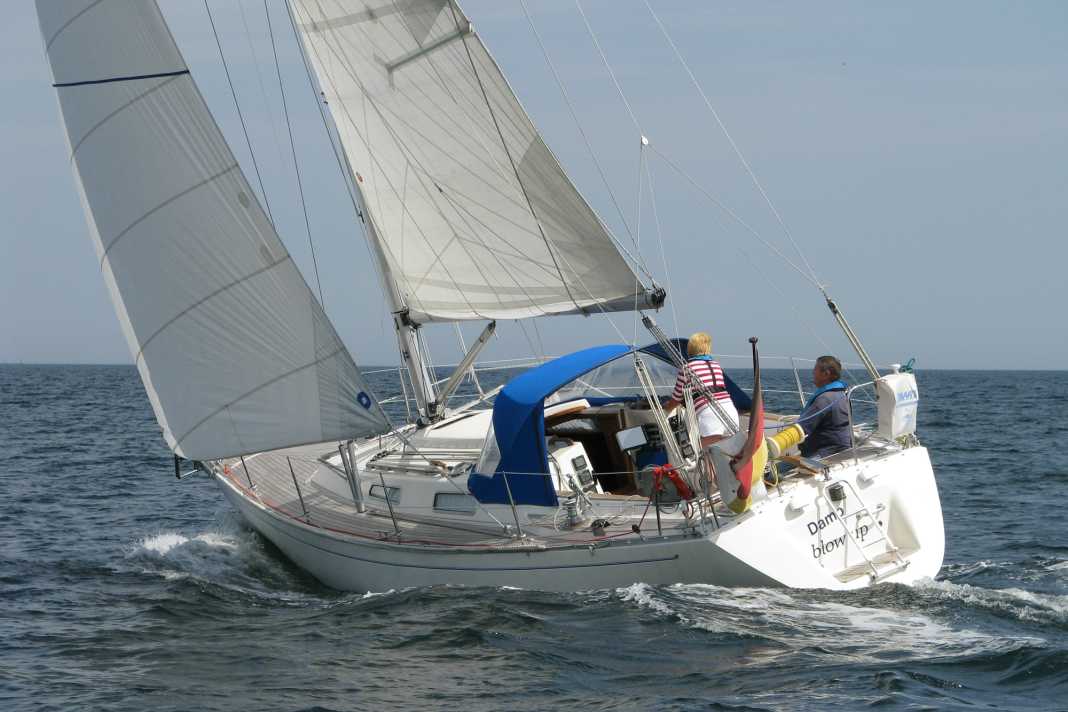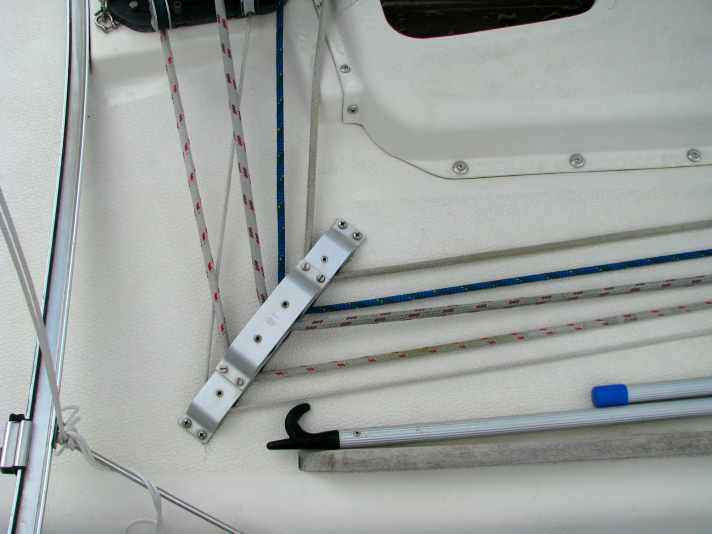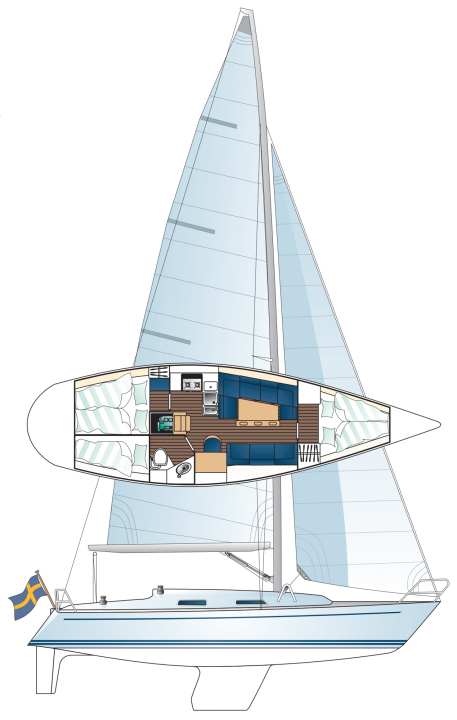Omega 36: Top design from a top designer in a used boat test






"Why an Omega 36 in particular?" we want to know from owner Armin Hahn from Bad Bramstedt. "She just looks great, that's particularly important to us. And she sails brilliantly. There are also very practical details, such as a deep bilge, a lead keel and tiller steering."
In fact, the yacht from Swedish mass production offers an exciting package. Produced between 1986 and 1991, the Omega is solidly built underwater, with the spray laminate reinforced with fibreglass. Above this, the hull has a Divinycell foam core. The deck is a balsa sandwich. At 5.1 tonnes for a boat length of eleven metres, the Omega is one of the lightest production boats of its time.
More used boat tests:
To give the hull the necessary strength, some of the fixtures were designed as a load-bearing structure made of GRP and laminated in. In return, however, the bulkheads are only bolted to the hull at flanges, a typically Swedish method. The same applies to the keel suspension. The lead fin hangs from a GRP stub, resulting in a deep bilge. Five floor ribs should transfer the forces into the hull. However, the workmanship is not equally good on all boats. As reports from experts in Sweden show, it is essential to check this area. If there are cracks or chipped topcoat, caution is advised and reinforcement is necessary.
Our test specimen is a well-maintained boat, built in 1988 and in third ownership. A lot of money and material has been invested in the boat over the years: the owners have installed a new teak deck, an additional refrigerator, a new gas system, the complete toilet installation with faeces tank and a comfortable slatted frame under the forward berths. You could almost have bought a new boat for the equivalent value.
The installation of a new stern tube went beyond the usual wear and tear. There was no other way to stop the leaks in the shaft system. According to owner Hahn, this is a common problem with Omegas with Yanmar engines. However, newer model years are equipped with a Volvo 2003 and Saildrive. Both variants are dual-circuit cooled.
Plenty of cloth
With the 36, Ron Holland launched a very fast ship onto the market at the time. With a displacement of only 5.1 tonnes, the Swede has a sail area of an impressive 78 square metres on a 7/8 rig, which, ex shipyard, manages without backstays and with only one pair of spreaders filed about 20 degrees aft. On the test boat, however, backstays were retrofitted to improve the trim.
With the genoa, the Omega achieves a sail load factor of 5.13, which is roughly the same as that of a more modern Bavaria match 35. Armin Hahn is correspondingly enthusiastic about the light wind characteristics: "On the wind we run a good 6.5 knots at three wind forces. However, with only two people on board, we have to put up the first reef from 4 Beaufort." This is hardly surprising, as the Omega has only 37 per cent ballast and a comparatively shallow draught of 1.70 metres. On the other hand, the standard self-tacking jib is also sufficient in wind forces of more than three, "then cruising becomes child's play," enthuses Hahn.
At the time, the Swedish shipyard offered wheel or tiller steering. The tiller takes up less space in the cockpit and below deck. From this point of view, it is a considerable advantage, especially in the harbour, if you want to place a cake stand. The routing of the halyards to the cockpit is not ideal. They are deflected at right angles, which leads to high friction losses in the plain bearing blocks.
The foresail hoist point can be set precisely on the very long rails - but you have to go on deck to operate the stoppers. Line adjustments were still the exception at the end of the eighties. Instead, self-tailing winches are on board as standard.
Living qualities
Compared to modern eleven-metre yachts, the space below deck is not generous. Nevertheless, Ron Holland has created good space conditions. In the foredeck, the Omega has a real double berth over two metres long. In the saloon, there is a U-shaped sofa to port and a longitudinal berth to starboard. For large crews, the table can be lowered and another double berth can be built. The aft section offers another double berth and a huge storage space on the starboard side, which can also be accessed from the toilet area.
There are extension versions that accommodate two double berths in the stern. However, these are berths for slim people, as the width of the boat in the stern is quite narrow compared to modern designs. Also not ideal: the hatches are tiny and the compartments are correspondingly dark.
There are also two different arrangements of the navigation corner, in front of and behind the bathroom. The large galley with double sink and fridge is well designed and executed. The toilet room is not spacious, but still adequate. The shower was standard equipment, which was not very common at the time. A sliding door leads into the cockpit. The woodwork is neat and offers good substance.
Conclusion
The Omega 36 is a very sporty yacht with a large sail area that can also be sailed by two people, not least thanks to the self-tacking jib, provided you reef in good time. The good construction pays off, so that even after 24 years there are no serious weaknesses. However, the keel suspension and, depending on the version, the stern tube should be inspected carefully before buying. Even though the boat can offer a maximum of seven berths, it is ideal for two or four people. The very successful shapes are still pleasing today - both in the harbour and under sail.
Problems & history of the Omega 36
The weak points
- Keel suspension: Not all Omegas are equally well laminated at the base. Damage can easily occur here after ground contact; chipped topcoat or hairline cracks are alarm signals

- Diverter: The large sliding hatch garage leads to strong deflection of the traps, which creates more
- Püttinge & Mast & Stevenrohr: There were problems with the weld seams on the rigging irons in the first construction numbers. The spreader fittings of the Isomat rigs should also be examined. The stern tubes of the Omegas tend to leak
The shipyard
The company behind the Omega was Svenska Familjebåtar AB, but the boats were actually built by the Bröjesson brothers in Bjästa in northern Sweden. The company had its origins in a factory for rubber gloves, but entered the boat industry in 1960. Over the years, Scanmar yachts, Maxis and Örnvik motorboats were produced alongside the Omegas. After the founding family retired in 1988, the company went downhill. The final end came in 1991. The last hulls were bought by Interboat and delivered until around 1993.
Model history
In the course of production, the Yanmar engine was switched to Volvo and Saildrive, and there are also some boats with modified rigs and differences in the interior fittings.
The market
By far the most Omegas can be found in the Swedish home territory. However, the price level is not necessarily better than in Germany, Holland or Denmark. Many yachts also went to England.
The Omega 36 in detail

Technical data of the Omega 36
- Designer: Ron Holland
- Lüa (torso length): 11,00 m
- Waterline length: 9,15 m
- Width: 3,36 m
- Depth: 1,70 m
- Weight: 5,1 t
- Ballast/proportion: 1,9 t/37 %
- Mainsail: 37 m2
- Furling genoa (100 %): 25 m2
- machine (Yanmar): 19.8 kW/27 hp
Price and shipyard
- Construction time: 1985-1991
- Quantity: 210
- Base price ex shipyard ('88): DM 120,000
- Average used price: from € 50,000
As of 08/2024, how the prices shown are defined can be found here!
Class association
www.omegaklubben.com (in Norwegian language)
YACHT review of the Omega 36
The Omega 36 is a Swedish quality construction that set standards at the time. The boat has excellent sailing characteristics and only a few weak points. The price level is comparatively high
Design and concept
- + Timeless, elegant lines
- + Different expansion variants
- - Fluctuating GRP processing
Sailing performance and trim
- + Very good sailing performance
- + Self-tacking jib, easy to operate
Living and finishing quality
- + Good room layout
- + Good wood processing
- - Dark aft chamber
Equipment and technology
- + Self-tailing winches as standard
- - Stern tube problematic
- - Heating placed unfavourably
This article first appeared in YACHT 22/2012 and has been updated for this online version.

